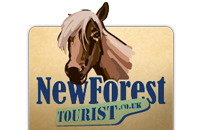Our week started well…
“Ringwood Brewery invites you to an afternoon touring the brewery followed by beer sampling and a hog roast”… As company event invitations go, this wasn’t one to refuse. Our MD’s suggestion that we cycle from the NFOL and Tinstar Design offices in Lymington to the other side of the New Forest on arguably the hottest day of the year was not, however, the best idea I’d ever heard. So one toss of a coin later, I was his smug passenger on the drive from Lymington to Sway, across to Burley and finally through Crow to Ringwood.
Our gracious hosts greeted us alongside the beautiful Ringwood Brewery dray horses that (used to) pull the Ringwood ale to its destination. Later, their experienced farriers worked in significant heat to change their massive shoes in clouds of steam. I look forward to seeing them in action at the New Forest Show this year.
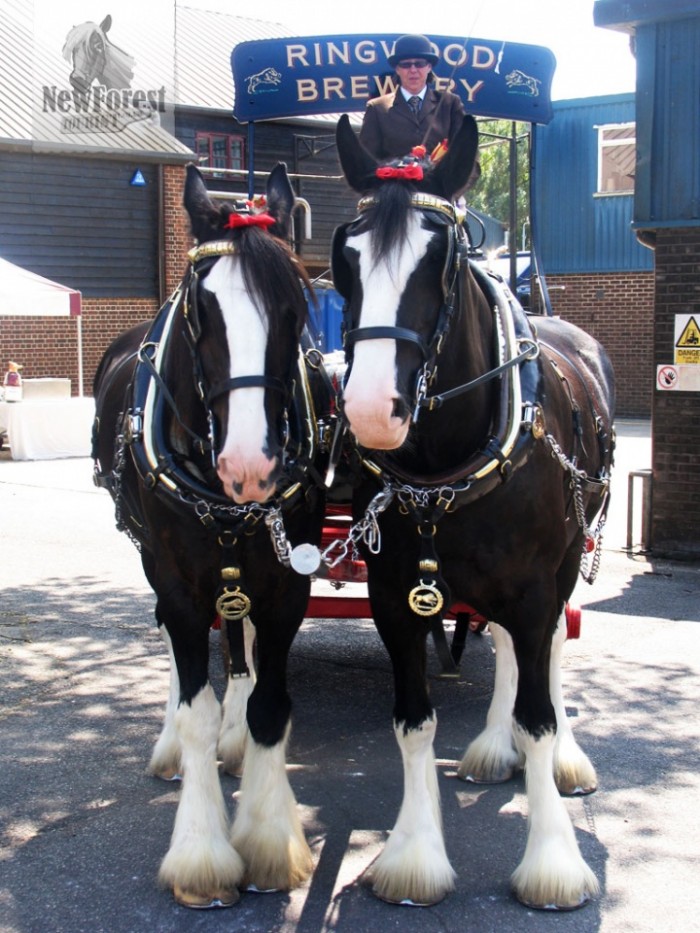
The magnificent Ringwood Brewery dray horses
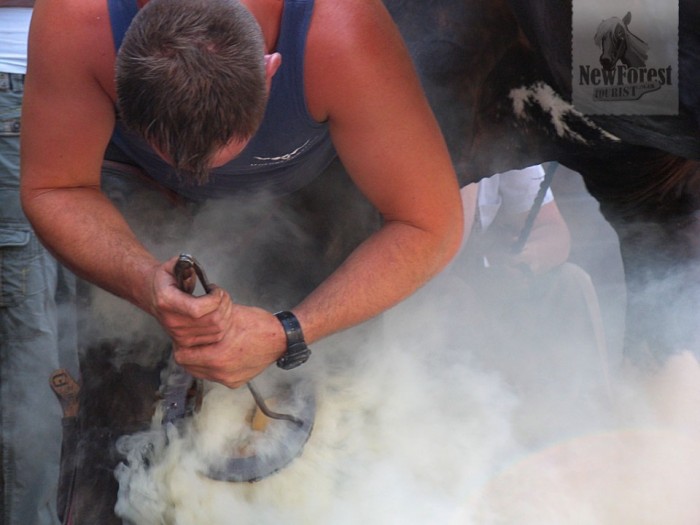
The heavy horse farriers replacing some very large shoes
In the cosy bar area (naturally the brewery has its own bar) we met up with our fellow guests, including Councillor Christine Ford, whose striking insignia and interest in the beer lent validation and great credibility to the beer tasting that ensued. I felt that I’d slipped under the radar onto the guest list… but quickly got over it as I tucked into another pint of the extremely welcome blonde Boondoggle and a couple of Old Thumper sausages.
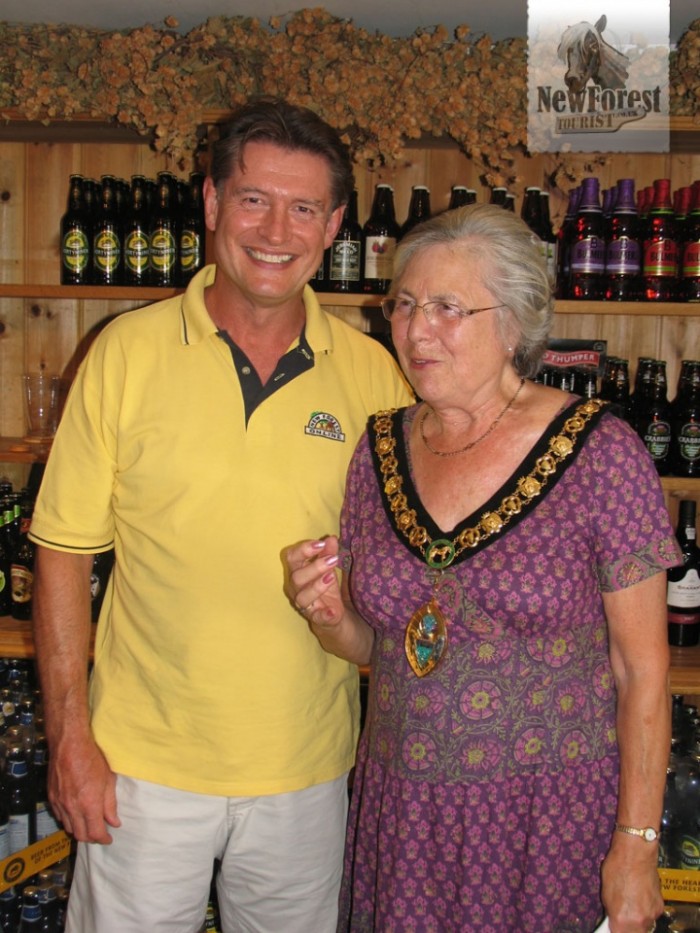
Mark Allen with Councillor Christine Ford as she strikes a pint-holding pose.
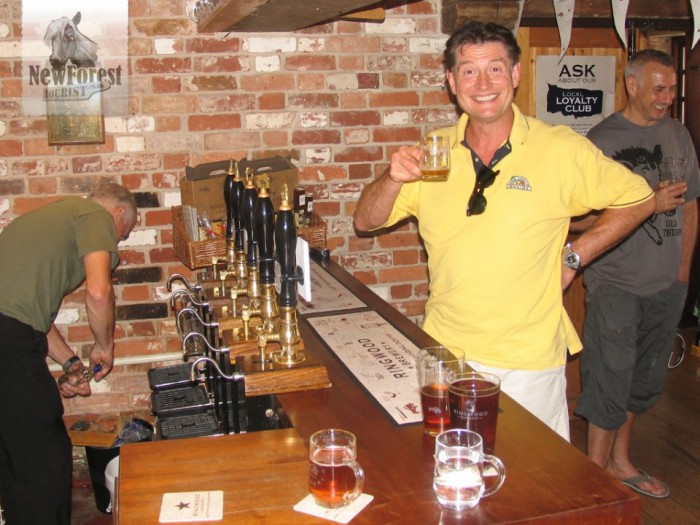
An extremely pleased Mark Allen of NFOL at the Ringwood Brewery bar.
Head Brewer, Jeff Drew, really knows his stuff – as do all the Ringwood Brewery staff that we met. There’s a real passion for the craft of brewing real ale that’s evident in the way they talk affectionately about the brewery and its small but perfectly formed range of ales (one of the brewery staff has been with the company for 30 years, joining when he was sixteen).
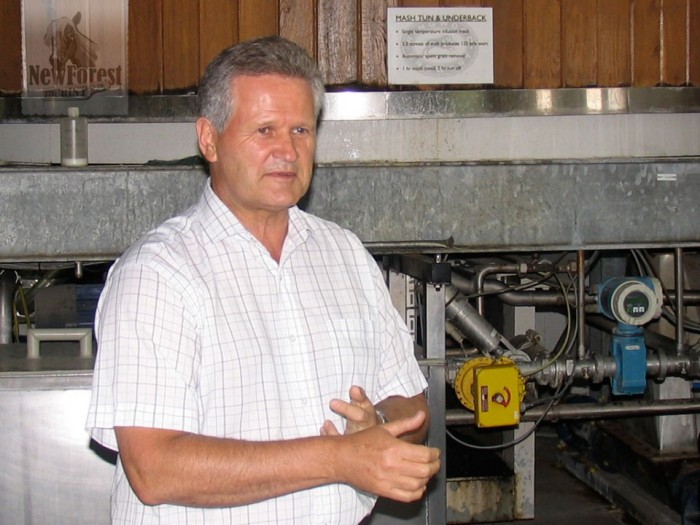
Head Brewer Jeff Drew leads the Ringwood Brewery Tour starting at the Mash Tun and Underback.
And they do love to talk about their beer – almost as much as they love to make it. The working day is long. Brewing starts at 4am and finishes at 8pm, during which time the ingredients making up the beer will have made their way from the Mash Tun, through the Underback into the Copper, along to the Whirlpool and into the Parallel Flow Heat Exchanger; and finally into the Fermentation Vessel. Eight hours later, it starts all over again for the second brew of the day.
In a given week, Ringwood Brewery prepares 7 brews. This translates to 800 barrels a week (give or take) – which (for the Master Brewer mathematicians amongst you) makes approximately 11 million pints a year… or as Jeff calls it, “a good weekend”.
The Ringwood Brewery Tour
The Brewery Tour, led by Jeff, takes visitors through the entire process – we even got to munch on some of the malt used for different beers (a strange after-taste; I’m still trying to work out whether or not I liked it).
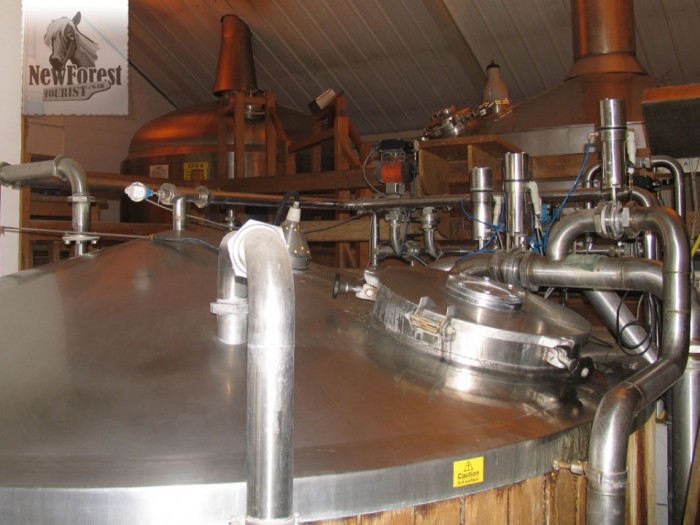
Above the Mash Tun, Copper and Whirlpool vessels
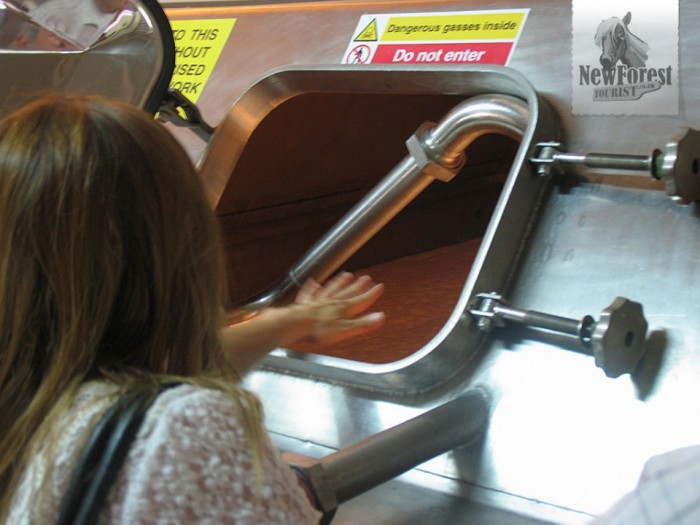
Feeling the heat of the chemical reaction in one of the Fermentation Vessels.
All the beers are brewed according to a simple recipe sheet; one which the brewers keep pretty close to their chest. It all comes down to what quantities are used of the common ingredients (malt, hops, water and yeast) and what proportions are added at which stage. This dictates the colour, strength, flavour and character of the beer. Sounds simple? It’s not. Jeff has a wealth of experience to draw on – and he needs it. One bad beer can cost thousands of pounds if it needs to be poured down the drain, as he has found out just once in his eleven years at the brewery – as this brief Q&A session revealed:
Question: Have you ever thrown a beer out?
Answer: “I’ve only ever thrown away one beer during my 11 years at Ringwood Brewery. It went through the system and somewhere it got an infection. It got into cask and wasn’t due to go out for another week or so. I tasted it and immediately knew that it wasn’t right. I opened another cask from the back of the run, tasted it and realised that it had got an infection. I had to go to the boss – I sat him down and thought of my P45… I told him that we had a problem with this beer and it couldn’t go out. It was 180 firkins (which was a fair amount of beer) that had an infection – and I wanted to stop it and brew it again. He said “Good decision. Well done… Don’t do it again.” And that was that… it did cost us a few thousand pounds in raw materials… which wasn’t ideal, but better than having bad beer go out into the trade and having people send it back.”
Question: How do you make a guest ale?
Answer: “Our illustrious marketeers usually come up with an idea of what they want. Chris Keating (Marketing Manager) will come to us and say “I want it to be a bit like this, with a taste of that; I want it to be this colour and this strength”. That’s normally enough for us brewers to go away and know how much malt, how much hops and how much water to add. How do we know it’s going to taste like that? Because it does. It usually tastes how we think it’s going to taste – we know how it’s all going to hang together. To say it’s going to taste exactly like something… well, that’s all in the eyes (or the mouth) of the beholder. But once you’ve done it once, the difficult bit is trying to reproduce it – and that’s why we’ve got recipes. If a client wants sixty barrels of, say, Old Scrungeit* or whatever, and it needs certain USPs for the particular brand, we don’t have a stab at it; we create the recipe, it gets brewed and that’s it. That’s the beer.”
*Not currently available!
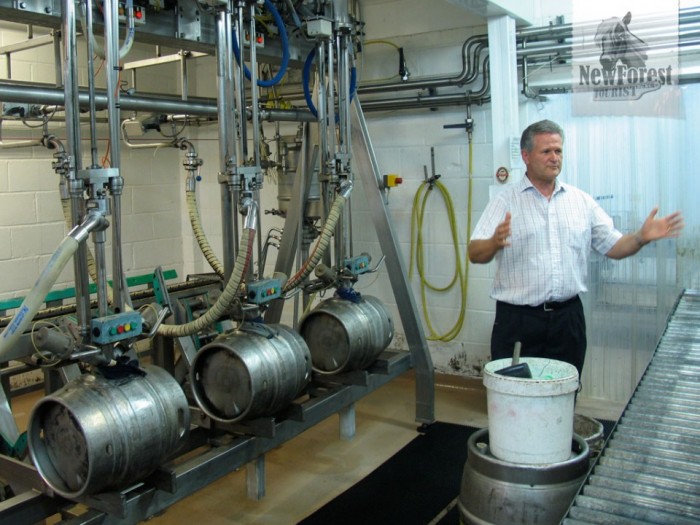
The tour over, Jeff Drew describes a fish he caught that morning.
The Ringwood Brewery ‘New Look’
Of course, the main reason for Ringwood Brewery’s event was that the business had just undergone a complete top-to-bottom rebranding exercise. This (apart from the reduction of the strength of Old Thumper from 5.6% to 5.1%) has been the topic for discussion in pubs across the New Forest.
My first discovery of the new design occurred the previous week when I ambled from the NFOL offices across the road to Lymington’s Angel & Blue Pig. I’d taken a photo of the Ringwood Best shield a couple of weeks before (for reasons I can’t remember), and realised it was no longer there. A new rectangle of wood-like resin was in its place – and it took a moment or two for my work-addled brain to work out that it was a new look for the same beer.
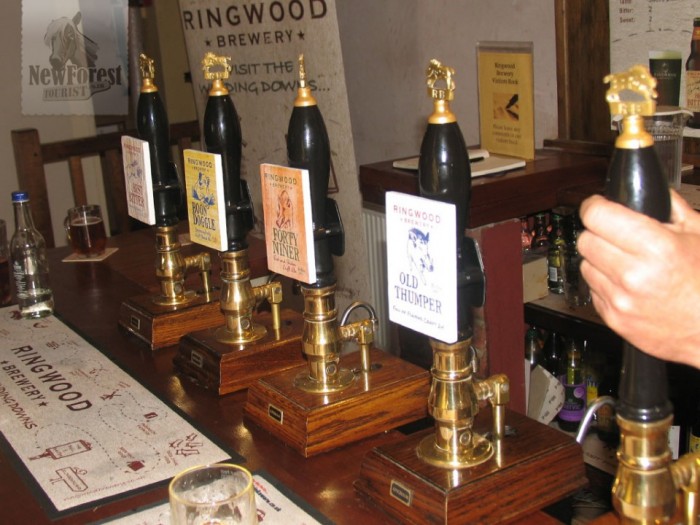
The four big boys – Best, Boondoggle, Fortyniner and Old Thumper dressed in their brand new togs.
I liked the new look straight away. But I’m not really the demographic that the brewery is reaching for. I’m already a Ringwood real ale drinker – even if I hadn’t liked the new branding, there’s little that would have stopped me drinking the beer. The move to refresh the look of the business is aimed more at younger drinkers – those who haven’t yet discovered the glories of high quality real ale. The references to ‘winding down’ and the increased use of Facebook and Twitter as a means of marketing is much more likely to attract the younger drinker; one that really needs to try Boondoggle instead of yet another pint of lager.
And to those young drinkers, trust us when we tell you that it’s worth it. We flatter ourselves at New Forest Online that although we may not be able to brew a good beer, we certainly know how to drink one.
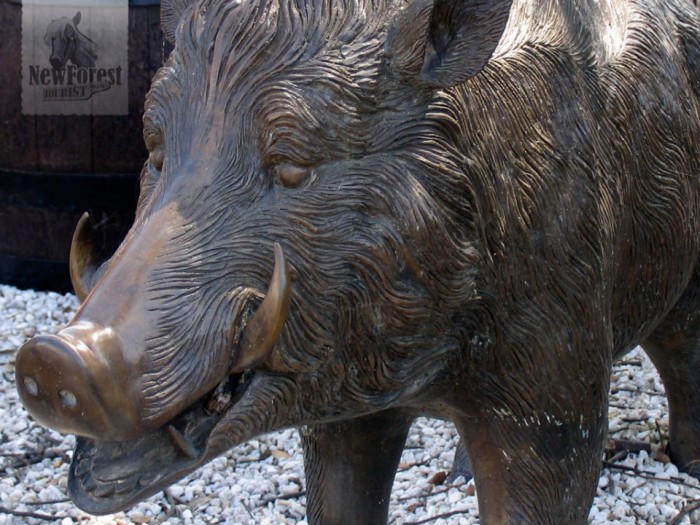
The Ringwood Brewery wild boar
A Pint-Sized History of Ringwood Bewery
- Ringwood Brewery was founded by Peter Austin in 1978 (originally occupying premises a stone’s throw from the current operation) brewing Best Bitter and Fortyniner.
- Old Thumper was born a year later, since when the lighter Boondoggle (amongst others) has been added to the permanent family of highly drinkable real ales.
Brewing in a Few Bullets
- The creation of cask ale is a completely live process; at no point is the beer pasturised.
- The ingredients pass from the Mash Tun via the Underback through the Copper to the Whirlpool and into the Fermentation Vessel within eight hours.
- Ringwood Brewery creates 7 brews a week, resulting in 800 barrels a week, which translates to 40,000 barrels a year… or 11 million pints a year.
- All the beer uses the same four raw ingredients:
- Malt (lightly roasted malt makes up 90% of the grist, or recipe)
- Hops (the aroma and bitterness of the taste depend on when and in what quantity the hops are added)
- Water (Supplied by Bournemouth & West Hants Water)
- Yeast
- The yeast used at Ringwood Brewery is a generation of the same yeast culture that has been used for over 30 years.
- A cask is thoroughly cleaned but not sterilised before being filled with 72 pints of beer. The beer is a live product, so will go off; therefore it requires a ‘best before’ sticker that advises consumption within 3-4 days after being opened.
